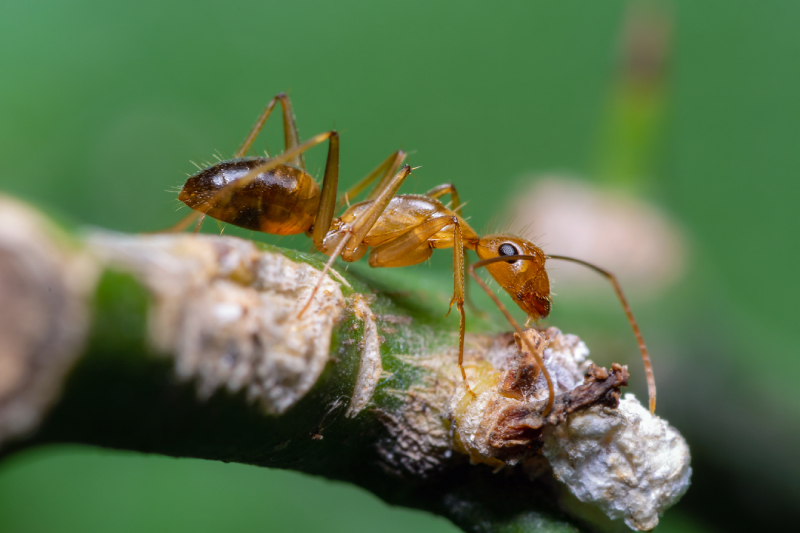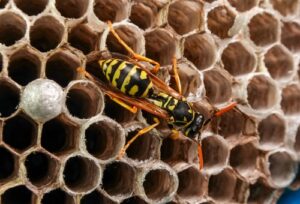Home / Blog / Ants / Five Reasons Ants Come Into Homes
Five Reasons Ants Come Into Homes

Scientifically reviewed by Daniel Baldwin, BCE, CCFS, CP-FS
-Published on May 14, 2020
-Updated on July 13, 2023
When ants invade your home, they can be challenging to eliminate and seem to come from everywhere. Have you ever wondered what attracts ants to your home in the first place? Here are five common reasons ants are drawn to homes, along with some essential prevention tips to keep your home ant-free, even with warm weather and high humidity.
What causes ant infestations?
Ants usually come indoors seeking shelter and food. They typically send out scouts who look for ideal conditions for the colony. If they find things like food residue, easy access to water, and accessible shelter, more members of the colony will follow suit.
Weather can also affect their behavior. If it’s cold or wet outdoors, ants are far more likely to start looking for indoor havens for protection.
Does killing ants attract more ants?
Unfortunately, yes. Dead ants release pheromones that alert nearby ants, who typically carry their dead back to an area called a midden. The midden holds dead ants, waste, and contamination to keep infections away from the hive.
Five reasons ants come into homes
No matter the species, most ants found in the U.S. are drawn into homes for similar reasons. Below are the top five reasons you’ll find an ant infestation in your home.
1. Sugary foods
Ants are often looking for accessible food sources, which is why infestations are widespread in kitchens, pantries, and places where food is stored. They like sugary, sweet foods, whether natural or artificial. Ants are attracted to things like spilled soda, sugary snacks, food particles, and even fruits & vegetables on the counter.
2. Grease
Left-behind grease and food residue—often on your stovetop, sides of food storage containers, countertops, or trash cans—is another factor that attracts ants besides food. These tiny food particles humans can often overlook essentially function as beacons to ants. Especially for restaurants, cleaning up grease residue is essential for keeping pests away.
3. Moisture
Many species of ants look for a constant and easy source of food and water. Ants are attracted to water because they need it to grow and reproduce. Leaking toilets, sinks, and fixtures can create ideal environments for ants, along with poorly sealed windows and doors. Standing water near backed-up floor drains or in laundry rooms can also cause an ant infestation.
4. Easy entry
Ants don’t need much space to get inside. Cracks in your foundation, holes in your walls, and poorly sealed windows and doors can all become entrances for ants. They can also find paths through walls and loose baseboards or gaps in floorboards.
5. Decaying wood
Leaky gutters or pipes after a rainstorm can cause wood to retain excess moisture in your home, which is often just enough to make it the perfect hideout for ants. Carpenter ants will burrow into soft, decaying, or waterlogged wood. Other species of ants can use paths already created by termites or carpenter ants to find access to shelter.
How to prevent ants from getting into your home:
Now that you know what draws ants into your home, you can take steps to avoid attracting ants and help prevent an infestation.
Clean up
Start by cleaning your kitchen regularly. Never leave crumbs or spills, and store food in airtight containers. You should also make sure to keep your trash stored in sealed containers.
Get rid of excess moisture
If you have high moisture levels in your home, use a dehumidifier to lower the moisture in the air. Check your home for any leaks that may let in moisture and repair water damage quickly.
Seal your home
The final step in ant prevention is to minimize their access. Check the exterior of your home for holes and cracks that may allow entry. Ensure all screens are intact and that all windows and doors have screens.
Common types of household ants
Several species of ants can make their way into your home, but they share many similarities and are generally attracted by the same things. Here are the most common types you’ll encounter.
Argentine ants
If you see ants walking in a very long, single-file line, you’re most likely looking at Argentine ants. They’re typically dark-colored, small, and known for joining forces with other colonies to produce super colonies that can be aggressive. Due to their size, Argentine ant bites cause minimal harm to humans.

Carpenter ants
Carpenter ants are red, brown, or black and typically around ½ an inch in size. They have recognizable heart-shaped heads and are wingless, except for the swarmers, which hatch during spring and summer. They’re often confused with termites because they have a similar size and also burrow into wood. Carpenter ants prefer to nest in damp or damaged wood where there is a lot of moisture.

Crazy ants
Crazy ants typically have a reddish brown color and are about ⅛ of an inch long. Although they tend to build nests outdoors and travel into buildings to forage for food, crazy ants can sometimes build their nests inside walls or in electrical equipment like air conditioner units. Known for taking over a yard or home quickly, their enormous populations, erratic movements, and stinging bite make them irritating pests.

Big-headed ants
Big-headed ants range in color from yellow to dark reddish-brown. They get their name from the major workers who have large heads compared to their bodies. They typically enter homes through cracks in the foundation. Big-headed ants are attracted to your yard and don’t generally nest indoors, but they will come inside to forage for food.

Odorous ants
The odorous house ant gets its name from the strong, rotten, coconut-like smell it gives off when crushed. They’re small and dark brown to black. They’re found throughout the United States and seek out moisture inside your home’s walls or beneath leaky fixtures.

Fire ants
Fire ants can be identified by their dull red color and stinger. These ants are attracted to heat and light and build visible soil mounds in sunny areas. They’re an aggressive ant species that feeds on living insects and dead animals. When inside a home, fire ants gravitate toward fats and sweet foods. They can sting and bite, causing painful, intensely itchy welts that can become blisters.

Pest control services
The best way to manage an ant infestation in your home is to hire a professional pest control service like Hawx Pest Control. With proven methods, qualified technicians, and the best products and services available, Hawx is the undisputed leader in pest control solutions. We offer safe and affordable extermination for your current problems and preventative treatments to address potential threats before they happen. Call us today for a free estimate to get your pest problem under control.
Related Articles
Visit our blog to learn more.
→






